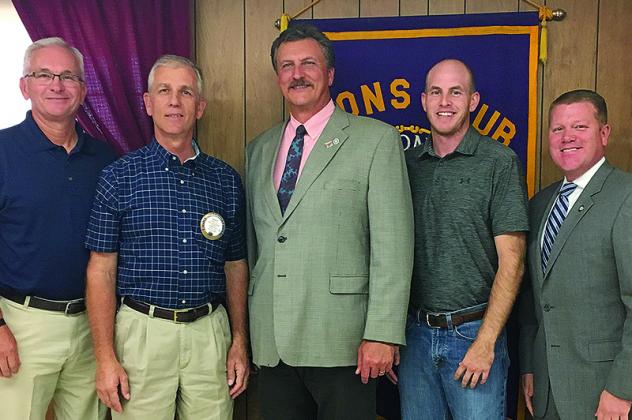Fingers crossed for just 1 month
U.S. 81 done by late October – if weather cooperates
Oklahoma Department of Transportation is sticking to its most recent estimate of late October for completion of the U.S. 81 improvement project south of Kingfisher – weather permitting.
“Highway 81 has been a big problem for y’all and I can do nothing but apologize for that,” recently appointed state Transportation Secretary Tim Gatz told Kingfisher Lions Thursday, reminding that last spring and summer’s unprecedented rainfall was a big factor in the project’s delays.
“We got a year’s worth of rain in a month and had more than 60 highways across the state closed at one point,” he said. “That’s the most significant rainfall I’ve ever seen.
“That puts contractors behind on every project they’ve got and before they could catch up, they had to cleanup.
“I wish I could have driven through a finished product getting here today, but it looks better than it did six weeks ago and in another six weeks it’ll look better than today.”
That apology and explanation was just a brief part of Gatz’s presentation, which focused on a broader view of ODOT’s history and mission.
Serving as secretary of the department since his January appointment and April confirmation, Gatz began his career with the agency as a drafting technician in 1990.
“When I started, we were drawing engineering plans in pen and ink, if that tells you anything,” Gatz said.
Gatz has previously served as executive director of the Oklahoma Turnpike Authority and deputy director of ODOT.
He shared the history of OTA, which was created in 1947 to fund the construction of the Turner Turnpike between Oklahoma City and Tulsa and was considered “the most innovative infrastructure mechanism in the country.”
“Route 66 had become so congested and we were seeing some horrific accidents,” he said. “We needed a modern, high-speed transportation corridor between Oklahoma City and Tulsa.”
The Turner Turnpike was completed in three years and opened in 1953.
To illustrate how advanced the project was, Gatz pointed out that the national interstate highway system wasn’t created for another three years.
“Our turnpike system continues to meet critical transportation needs that would otherwise go unmet,” he said. “Even if you never drive on a turnpike, you’re wrong if you think you’re not affected by it.
“Turnpikes allow us to stretch our limited tax dollars and other resources on the rest of the highway system.”
All of that happens while the state continues to keep its tolls at 60% below the national average, he said.
Gatz recognized State Sen. Darcy Jech and State Rep. Mike Sanders, both present at the meeting, for their legislative support of the state’s transportation system.
“We’ve had no better champions for infrastructure investment than these two men,” he said.
Once funded only by a portion of the state’s motor vehicle tax, a flat $200 million annually that did not increase from 1990 to 2006, the transportation system now gets an additional annual appropriation that’s been used to catch up on significant maintenance problems over the last 13 years.
“We were barely keeping things glued together when I started with the department in 1990,” Gatz said. “We had 1,200 structurally deficient bridges in 2006 across the state and were ranked 49th in the country.”
The legislature created a roads fund in 2006 that added another $575 million in annual allocations for roads and bridges.
“At the end of last year, we were down to 132 structurally deficient bridges and now we’re down to 112 at last count,” he said.
“Our goal is to be at less than 1% next year, which will put us in the top 10 in the country,” he said. “We’re ranked at 13th right now.”
That number does not include county road and city street bridges, for which ODOT is not responsible.
“Our jurisdiction includes the federal and state numbered routes and the interstates,” Gatz said. “There are about 17,000 county road bridges and about 3,000 of them are rated structurally deficient.”
Another of ODOT’s priorities is to add paved shoulders to two-lane highways, which Gatz said is considered at least four feet of paved surface beyond the outside lane stripe.
“Our highest accident rates are on rural two-lane highways without shoulders,” he said. “We have horrific, awful accidents, either from vehicles going off the edge and crashing into trees or other obstructions or overcorrecting and driving into oncoming traffic.”
Adding shoulders to S.H. 33 between Kingfisher and Watonga is one of the department’s priorities, Gatz said.
He also emphasized the need for driver caution in construction zones.
“We’ve lost 61 people in the line of duty who were struck by vehicles in construction zones,” he said. “That’s more than any other state agency.
“We’ve had another 700 fatalities among the traveling public in construction zone accidents.”
ODOT Division 4 Engineer Trenton January also was present for the Lions program.
Gatz was introduced by Lions Club member Chase Farrar.

